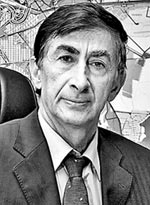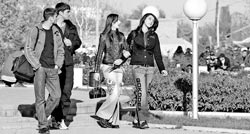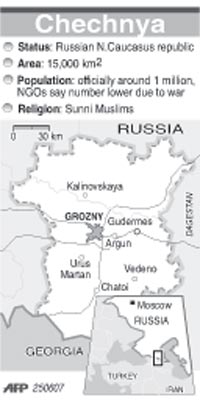
Chechnya: Where war on terror is murder racketGROZNY, Russia, (AFP) - A shredded body, an explosive belt and an intact head was all that remained of a Chechen woman found in May 2005 in Grozny. Two years later, the case has shed rare light on the gory mechanics of disappearances and murders in Chechnya. Until last December the body was registered as that of a suicide bomber intercepted by men working under police captain Ruslan Asuyev. But now Asuyev is charged with the kidnapping and murder of this young woman. The terrorist label, the federal prosecutor general says, was an invention Asuyev concocted to earn a promotion.
Due to "the desire to boost his service record and to get ahead he kidnapped and killed a woman, presenting her death as the elimination of a terrorist," the prosecutor's office said in a statement last month. The office also said that though the total number of kidnappings and executions in the republic has dropped significantly in the last five years, there is an alarming "increase in the number of illegal armed groups including members of law-enforcement bodies" in Chechnya. The admission marks a break from years of official denials, which up to now have said that forces under Moscow's control -- the army's special services, supporters of Chechen President Ramzan Kadyrov and police with connections to former rebels -- had no link to the disappearances. Local government officials say as many as 2,800 people had been listed as abducted or missing, according to Amnesty International. But Memorial, a human rights group in the Chechen capital Grozny, said that up to 5,000 have disappeared since 1999, when President Vladimir Putin launched the second war in a decade to crush a Chechen separatist movement -- a conflict that human rights activists say has been marked by mass war crimes. "We have denounced this kind of things for several years, but this is the first time that a Chechen policeman has been put on trial for kidnapping and assassination," said Natalya Estemirova, an expert at Memorial. Sifting through documents from the 2005 case file, including gruesome details on the condition of the woman's body, she described a racket that extended back three years. According to the prosecution documents, Asuyev's group of 14 men included former police officers and amnestied rebels. They are accused of running protection rackets, seizing civilians for ransom and carrying out kidnappings and murders -- all under the cover of the fight against terrorism. Asuyev's lawyer, Badrugin Bodylayev, refused to comment, other than to dismiss the accusations as part of a power struggle between different law enforcement bodies.
Prosecutors also refused to comment, but prosecution documents seen by Memorial allege that on May 6, 2005, Asuyev's men killed the woman in the street before carrying her body away. They then attached an explosive belt which they detonated -- before writing up a report on the "liquidation" of a terrorist. Another case, also due to be tried soon, alleges that Asuyev killed Khamzat Gaitukiyev, a 30-year-old Chechen. That time the procedure was different: officers proposed he join the police force then set him a test of opening fire on a car full of rebels. Instead of ambushing guerrillas, Gaitukiyev found himself facing a vehicle full of law-enforcement officials who gunned him down as a "terrorist." A group of investigators and police officers from the federal interior ministry and members of the criminal investigator's office (ORB-2) in Grozny finally caught up with Asuyev, who was hiding in the Astrakhan region of Russia. Nine of his colleagues were also arrested. But in the legal mess of Chechnya today even those investigating the criminals, such as personnel at ORB-2, play dirty, human rights activists say. "These same police officers are involved in the escalation of the violence, with recourse to torture," said another source with access to the Asuyev case file who asked to remain anonymous. "The whole system is rotten." In March the Council of Europe published a report denouncing the use of torture with impunity in Chechnya, singling out actions by ORB-2. In Memorial's office, Zhabrail Abubakarov, a young lawyer, discussed such a case with Issa Khisimikov, a civil servant from the emergency situations ministry whose nephew was allegedly tortured by ORB-2. According to Abubakarov, the nephew Uvais and four other students were stopped by police in May 2006 in Grozny, accused of shooting Russian soldiers or police officers, then taken to ORB-2 where they were beaten and administered electric shocks. After they "confessed," Uvais was charged with "eleven attacks involving use of explosives or automatic weapons" and put in detention, where he tried to commit suicide by slitting his wrists. His lawyer says he is innocent. "I succeeded in proving that for at least six of the attacks, someone else had already been arrested, tried and sentenced or that Uvais could not have been in Chechnya at the time of the events," said Abubakarov, showing documents to back up his argument. "In the (Chechen) prosecutor's office, no one wants to get to the truth so that instead they can close the maximum number of cases," he said. "The whole system is corrupt, from the police officer who carries out kidnappings to the judge who presides over trials. Everyone is making money or a career at the expense of locals."
|
|| Front
Page | News | Editorial | Columns | Sports | Plus | Financial
Times | International | Mirror | TV
Times | Funday
Times || |
| |
Copyright
2007 Wijeya
Newspapers Ltd.Colombo. Sri Lanka. |


 MOSCOW (AFP) - Chechnya, which has fought two brutal separatist wars with Russia since 1994, is slowly rebuilding.
MOSCOW (AFP) - Chechnya, which has fought two brutal separatist wars with Russia since 1994, is slowly rebuilding.